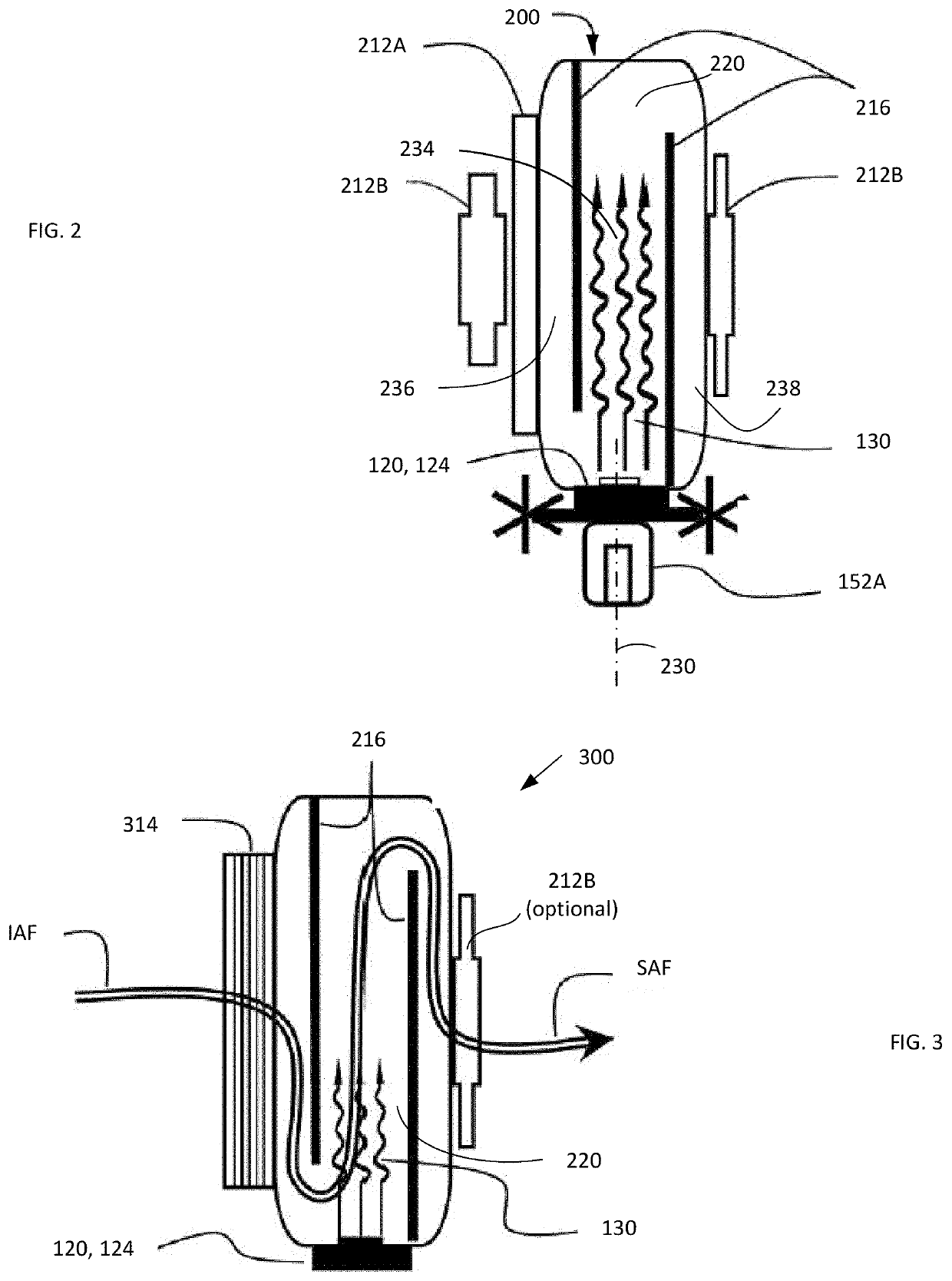Portable uv-c pathogen inactivation apparatus for human breathing air
a technology of inactivation apparatus and uvc, which is applied in the field of personal protective equipment, can solve the problems of airborne viruses or bacteria that are not completely stopped by particulate filters, the effect of reducing moisture content, high reflectivity, and reducing the size of most viruses
- Summary
- Abstract
- Description
- Claims
- Application Information
AI Technical Summary
Benefits of technology
Problems solved by technology
Method used
Image
Examples
embodiment 100
[0020]FIG. 1A provides a schematic of an embodiment 100 of the air-sterilization apparatus, showing, in general, a sterilization unit 110, defining a fluidly sealed inner chamber or cavity (which may contain air baffles extending between the opposite sides of the chamber, as discussed below) and having an inlet port 112 through which an intake air flow (shown as IAF) can be received by the unit 110. The source 120 of UV-light (preferably juxtaposed with the heatsink 124 for removal of waste heat from the UV emitter of the source 12) is appended to a side of the sterilization unit 110 and radiatively connected with the inner volume (chamber) of the unit 110 via an appropriate optical port (not shown) to irradiate (130) the inside of the inner chamber with a virus-inactivating radiation and with it—the flow of air A passing through the unit 110. The axes of the inlet port 112 and of the optical port are substantially transverse to one another. The sterilized air SAF is fluidly passed ...
embodiment 200
[0025]FIG. 2 depicts an embodiment 200 of the air sterilization unit 110 of FIG. 1, showing the inlet port 112 with an air intake grill 212A and / or air intake hose connection 212B. The inner chamber 220 of the unit 200 is preferably equipped with contains one or more air flow baffles 216 that are positioned and dimensioned to direct (uniformly channel) the incoming air through the space of the chamber 220 irradiated (130) with UV-light from the source of UV radiation 120 and to minimize the shortcircuiting.
[0026]The source 120 preferably includes an UV-C light source such as, without limitation, one of those provided by Klaran Crystal IS Green Island N.Y. USA, Bolb, Inc Livermore Calif. USA, Seoul Viosys, Gyeonggi-do Republic of Korea, Shenzhen Guangmai Electronics Co. Ltd. Shenzhen Guangdong China, as known in the art. In a preferred embodiment, the source 120 is configured to contain at least one UV-C LED emitting light at wavelength(s) within the range of 250 nm . . . 290 nm with...
embodiment 300
[0037]The operational and dimensional characteristics of other constituent components and elements of the embodiment 300 may be chosen to be substantially the same as those discussed in reference to FIG. 2. The commercially available particulate filter 314 may be chosen to include N95 or P100, and HEPA filters for pathogen filtration. Such commercially available mask manufacturers selected from the group comprising 3M Company, St. Paul, Minn.; Mine Safety Appliances (MSA; Honeywell International Inc, Charlotte, N.C.; Jayco Safety Products Pvt. Ltd., Borivali, Mumnai, India; Draegerwerk AG & Co. KGaA, Lubeck, Germany; Gentex Corp, Zeeland, Mich., for example.
[0038]Depending on the specifics of design of filter 314, the air grill 212A may not be required, but the presence of the hose connector 212B may still be needed for ventilators, breathers, and CPAP machines. Information presented in FIGS. 11, 12 and Tables 2 and 3 is equally applicable to the operation of the embodiment 300.
PUM
| Property | Measurement | Unit |
|---|---|---|
| diameter | aaaaa | aaaaa |
| diameter | aaaaa | aaaaa |
| size | aaaaa | aaaaa |
Abstract
Description
Claims
Application Information
 Login to View More
Login to View More - R&D
- Intellectual Property
- Life Sciences
- Materials
- Tech Scout
- Unparalleled Data Quality
- Higher Quality Content
- 60% Fewer Hallucinations
Browse by: Latest US Patents, China's latest patents, Technical Efficacy Thesaurus, Application Domain, Technology Topic, Popular Technical Reports.
© 2025 PatSnap. All rights reserved.Legal|Privacy policy|Modern Slavery Act Transparency Statement|Sitemap|About US| Contact US: help@patsnap.com



